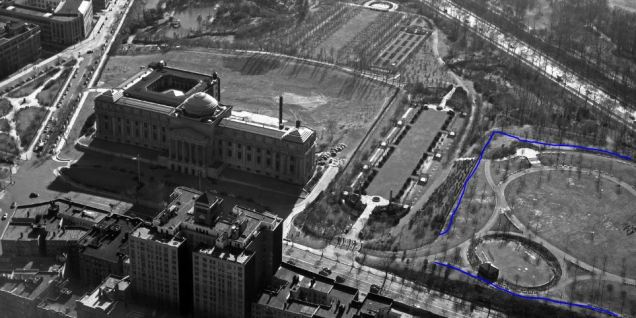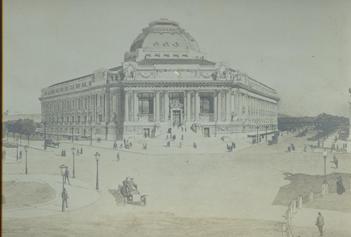This week’s selected photo is a former reservoir located in Mount Prospect Park, Brooklyn. The photo comes from the Library of Congress’ extensive online collection.
Taken in the early 20th century by Detroit Publishing Company, it was used as a postcard image. Where the central library of the Brooklyn Public Library now stands used to be an iconic Romanesque revival water tower. The photo is looking west towards the New York Harbor and on the horizon is New Jersey. Unrivaled views were once available from this hilltop reservoir.
Prior to development, the eight-acre Mount Prospect was known as the second highest point in Kings County at the height of 198 feet. To its southeast, Flatbush Avenue passed through the heavily forested terminal moraine that is preserved within Prospect Park. During the American Revolution, this hilltop served as a lookout point by Washington’s army as it guarded Flatbush Pass. In the postcard image below, the hilltop is to the right of Flatbush Avenue.
 .
.
In 1856, the city of Brooklyn acquired the site for a 3.5-acre reservoir north of Flatbush Pass. Water for the reservoir originated in the dammed streams of southern Nassau and Queens Counties, flowing through a conduit towards Ridgewood Reservoir and then through another conduit towards Mount Prospect.
Viele and the Reservoir
Within four years, the reservoir was zoned within Prospect Park on the belief that the greensward would shield the drinking water from encroaching development. As with Central Park, Brooklyn’s Prospect Park went through several design phases before settling on the Olmsted plan. One of the alternative designs was submitted by Ludovicus Egbert Viele, the foremost expert on hidden streams at the time.

Viele’s plan would have placed the Mount Prospect Reservoir in the center of the park. A phantom of the imagination, Viele’s park did not include what later became Eastern Parkway and Grand Army Plaza. Its botanical garden would have been inside the larger park, but that park’s lake would have been quite small. A flower garden and hilltop esplanade were planned for the sides of the reservoir. As with today’s Prospect Park, it is bisected by Flatbush Avenue.
Olmsted and the Reservoir
In Frederick Law Olmsted’s 1870 vision for Prospect Park, a much larger lake was planned for the southern side of the park, while the land around Mount Prospect Reservoir would be sold to developers to finance the park. Sounds a bit like how Brooklyn Bridge Park is being funded. Nothing new under the sun. The larger “for sale” block to the left of the reservoir later became the Brooklyn Botanical Garden. As with the corners of Central Park, Olmsted’s Prospect Park included plenty of traffic circles at its edges. Unlike Central Park, only 3 out of 5 are around today. The one at Ocean and Parkside Avenues is only a half-rotary. Another at Prospect Park Southwest and 16th Street was later straightened.

The Iconic Water Tower
The demand for water in the growing city led to demands for a water tower that served to boost property values and prevent fires. A Gothic-style tower made of pink granite was completed in 1892 by architects Henry W. Thayer and William J. Wallace. The photo below, taken in 1915 comes from the Museum of the City of New York collection. The tower is not leaning, despite its appearance as such.
Another architectural curiosity built by the reservoir was its gatehouse, a classicist structure that housed a water testing laboratory. The photo below comes from the same collection, taken in 1900 by George P. Hall from the top of the Water Tower. The view looks south at an undeveloped superblock that later became the botanical garden. On the right are Flatbush Avenue and Prospect Park.
Obsolescence
The annexation of Brooklyn by the City of New York in 1898 sealed the reservoir’s fate. With the Croton and later the Catskill and Delaware watersheds quenching the expanded city’s thirst, Mount Prospect Reservoir was no longer needed and discussions were held for its decommissioning. Looking at it from Grand Army Plaza, it was clear to proponents of the City Beautiful movement that the reservoir’s slopes could be developed as a public institution. Already by then, Brooklyn Museum was under construction, rising above the level of the reservoir. Sadly, only two of its four Beaux Arts wings were completed as the museum was overshadowed by its counterparts in Manhattan following the 1898 annexation of Brooklyn.

In a 1952 aerial survey that is in Brooklyn Museum’s collection, one can see the incomplete museum. On the site of Mount Prospect Reservoir (marked in blue) is a park, but more on that later. Between them is the northern entrance to Brooklyn Botanical Garden.
Brooklyn Public Library
As with the Brooklyn Museum, the borough’s main library was also initially a beaux arts design that was never completed. Ground was broken for the facility in 1912, promising a beaux-arts design by Raymond F. Almirall that resembled the New York Public Library and the Brooklyn Museum.
Unfortunately, from day one budget cuts and unfavorable economic conditions slowed construction. For the next quarter century, only one of Almirall’s three wings stood completed, facing Flatbush Avenue. In the meantime, steps were taken to enlarge the library. On January 22, 1930, workers began demolishing the Water Tower. Within two weeks, work was complete. Its pink granite bricks were available fee of charge to anyone, so it is possible that there are buildings throughout Brooklyn comprised of the tower’s remnants.
In 1935, the city hired architects Alfred Morton Githens and Francis Keally to simplify Almirall’s design. The result was an Art Deco design with very little ornamentation, no dome and only two of the three building wings complete in the triangular floor plan. The library holds more than a million books within its walls and the Brooklyn collection on the borough’s history.
Mount Prospect Park
Nothing remains of the Mount Prospect Reservoir today, although there is one wall outside the library with a watery design that may relate to the reservoir. Once panoramic views have been obscured by mature trees and beyond them, co-op apartments and condo towers. In theory, there is room within the park or behind the library to rebuild the Water Tower, but when you have condo towers in downtown Brooklyn rivaling the skyscrapers of Manhattan, the Water Tower would serve no purpose, neither for storing water nor for tourism.
The park is hemmed in by Brooklyn Public Library and Brooklyn Botanical Garden. Its name is almost identical to the borough’s most famous park, located a few feet away. Both of its entrances are on Eastern Parkway, rising on a slope towards a playground and a lawn.
Flatbush Avenue separates Mount Prospect Park from Prospect Park, running through a pass between the hills. The smaller park’s isolation could be resolved with a pedestrian bridge above Flatbush Avenue.

On the map above, I marked the possible site of a bridge in gray. It could be given a Victorian design to fit with Prospect Park’s other bridges, or a kitchy miniature of the Brooklyn Bridge. With its views of the Soldiers and Sailors Arch and the borough’s most famous avenue, this bridge would easily become an attraction. Nevertheless, the historic landscape of Prospect Park is carefully guarded by the park’s advocates and any changes would take years to approve and construct.
Note: This Sunday, March 20 at 2 p.m. is my book launch event at Greater Astoria Historical Society. I hope to see you there. IF you cannot attend, scroll up to see other upcoming author events.
In the News:
- Financial Times profiles the lives of individuals working along London’s River Thames.
- DNAinfo looks into the costs of the harvesting machine that clears weeds from Prospect Park’s lakes. They call it the Lake Ness Monster.
- Queens Chronicle reviews my book. I used to be a freelance reporter for this paper between 2009 and 2011.








5 thoughts on “Photo of the Week”